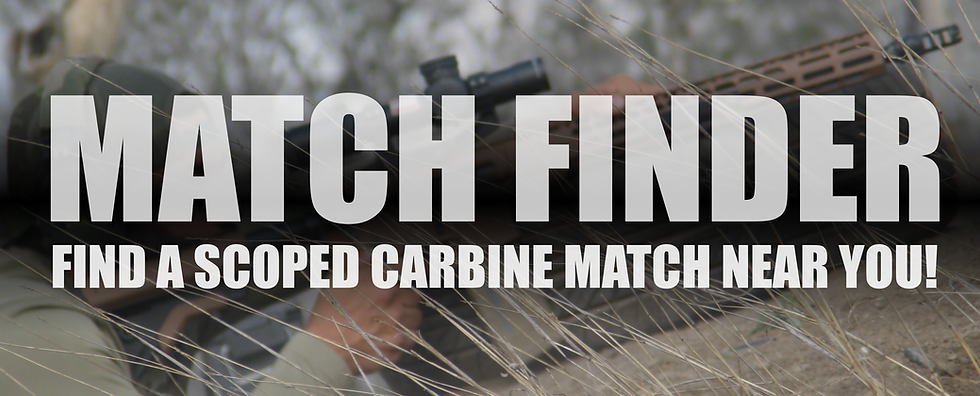Natural Point of Aim: A Component of Stable Firing Positions
- Sun and Shadow
- Jul 1, 2023
- 4 min read
Updated: Jul 5, 2023
Do you struggle with recoil management or large wobble zones when firing from alternate positions? Your body position is likely to blame. Understanding the rifle's Natural Point of Aim, or NPA, will put you on the road to more stable shooting positions. While NPA is not the complete answer to securing a stable position, it is a key factor to set yourself up for success. This guide provides an overview on building, checking, and adjusting NPA.

Natural Point of Aim is the location of your scope's reticle when both the rifle and your body are in the relaxed state. NPA is determined by your body's position behind the rifle. Ideally, NPA will always have the reticle on the target. Incorrect NPA will lead to unstable firing positions, poor recoil management, inconsistent shot placement, an inability to self-spot your shots, and muscle fatigue. "Muscling" the rifle onto the target and wobbly sight pictures are indicators of poor NPA.
Achieving NPA:
NPA can be achieved with the combination of several steps. First, the rifle must be set up to your body. In the same way that the driver's seat of your car or your office chair are always set to a position that you like, your rifle must be set up the same way. The items to review when setting up a rifle for your body include eye relief of the optic, height of cheek weld behind the optic, and the length of pull (distance from the trigger to the back of the stock). Note that the length of pull can change depending on body position. For example, there can be a required change in length of pull when moving from kneeling to prone positions due to the change in the stock's contact point with your shoulder.

Next, we should do our best to square our hips and shoulders to the target. Squaring the body to the target is the most efficient way to control recoil and ensure that the body is pushed straight back under recoil, rather than rotated around the spine as a center axis. When shooting from prone, we should align the spine to be parallel with the rifle.

Next, rearward pressure should be applied to the firing hand grip, such that the grip pulls the stock directly back into the shoulder. Too much pressure will result in muscle fatigue, but too little will not be enough to control the rifle during recoil. Apply the same pressure as a firm handshake.

Next, we must consider what to do with the support hand. If firing from the prone or modified prone positions, the support hand should control the rear bag and the stock. If working from other positions while using a support or prop, such as standing, high or low kneeling, or sitting, we should control the fore end of the rifle. Pressure from the support hand should usually push straight down in order to be neutral, but the prop may dictate that rear or forward pressure is applied. Direction of pressure is situation-dependent. Again, the pressure applied here should be about that of a firm handshake; we should not experience muscle fatigue in the support hand. Also remember to keep the support shoulder square to the target; don't reach too far to the front of the rifle.

Finally, your body should be positioned for a neutral center of gravity; weight should not be so far forward or back that you would fall over if the prop was not supporting you. A neutral center of gravity can usually be achieved by widening or closing the legs or knees to provide correct body elevation, and moving the hips inward in order to align shoulders, hips, and legs. A wide, low base will usually be more stable than a higher position, but this may not always be possible based on the situation or prop.

Checking Your NPA:
There is a simple check we can perform to determine if our NPA is on the target or not.
Enter the desired shooting position and get the reticle on target.
Move through all of the steps in the above section in order to build a position.
Relax your muscles, save for the pressures applied to the grip and fore end. Bone support is critical for consistency.
Close your eyes. Breathe in slowly for 1 to 3 breaths.
Open your eyes. Is the reticle still on the target after your breaths?
If the reticle is not still on the target, shift your hips and repeat the process. If the reticle is on target, then you have achieved proper NPA.
Adjusting NPA
In order to adjust your Natural Point of Aim, shift your hips in the direction of the reticle. If the reticle is off target to the left, shift your hips left. If the reticle is off target to the right, shift your hips right. Only a small movement is typically necessary; usually just an inch or two. This movement of the hips will adjust your entire body so that the rifle remains on target without major muscle inputs. The body must move to adjust NPA, not the rifle.
Natural Point of Aim can be a difficult concept to grasp, and it is not always easy to find it right away, especially in a competition setting. However, the more you practice achieving NPA in various positions, the faster you'll be able to find it when you need it most!




Comments